Report: Michinoku traditional folk performing Arts festival ~The Deer Dance
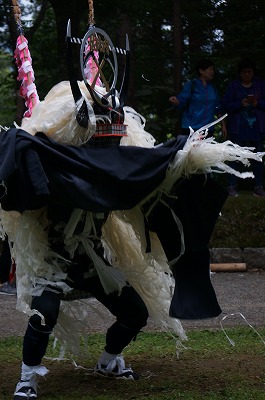
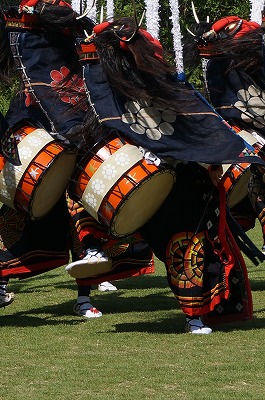
All about Shishi Odori
The Shishi Odori (the deer dance) is a performance unique to the Tohoku region. There are many theories about its origin but it is not well known. Some scholars (mainly around Kyoto) say that it was modified by the propagation of some of the performing arts from the capital , while others from the northeast claim that it developed on its own. The word “shishi” is often compared to “shishi-mai” (lion dance), but in this region the “lion dance” is called “Gongen-mai” and exists separately. The word “shishi” generally refers to an imaginary animal of Chinese origin, but it also meant animals themselves in general (although it is rarely used today). In Kanto, the “wild boar” is called “shishi”, while in the Tohoku region, the word “shishi” came to mean “deer”, because the deer was the most accessible prey in the Tohoku region (this is also confirmed by relics). Legend has said that this dance was started to make offerings to the prey. It can be said that this kind of thinking was not common in the capital because the division of labor was well developed in the city. The people who ate did not think about the people who caught and dressed it. It was different in Tohoku. Animals were closer to them. It can be said that this is why people had a strong sense to make offerings.
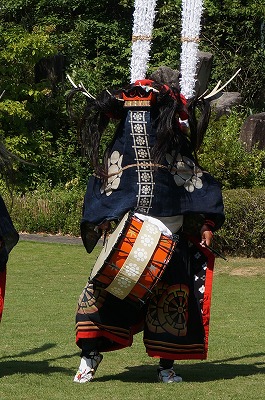
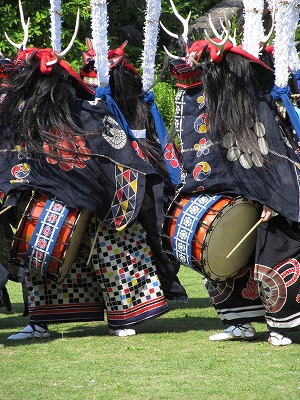
The most unique aspect of the Deer Dance is its visuals. When transforming as an animal, Europeans often try to be the animal itself, wearing furs and such. In Africa or Papua New Guinea, they try to cover their bodies with leaves and other natural materials to appear as something other than this world. The Japanese tend to try to leave behind a human figure. They may use part of the animals, but only a little. More often than not, they don’t use them. Shishi odori (Deer dance) is one of the few exceptions to this rule.
We can find Deer Dance in Iwate, Miyagi and Yamagata prefectures. In Iwate Prefecture, the Deer Dance can be divided into two groups. : those danced by a large group of people and those performed by the deer themselves, who beat the drums. This is said to have originated in the 18th century (Edo period) when the area was divided into two feudal domains of feudal lords. The Nambu clan ruled in the north and the Date clan in the south (and Miyagi prefecture). In the former Nambu domain, one group involved dancers in large numbers, while in the former Date domain, the Shishi (deers) themselves often beat the drums. This group is also seen in Miyagi prefecture.
The position of the deer dance in this festival
The Deer dance is one of the most popular performance of this festival along with the Ogre Sword Dance. It can be seen at several venues, but the best place to see it is in the “Shiika no Mori Park” on Saturday afternoon. “The Shiika no mori park” means “the poem park”. The Northeast region has produced many poets. There are also a number of poems written about the region. There is a facility in the park that specializes in poetry. (It should be. To tell the truth, I was too busy watching the performing arts to have time to look at the park.) There is no doubt that it is a beautiful park, covered with lawn and lush with trees.
The event starts at 1:00 p.m. Each group will perform every 20 minutes. In previous years, all of them have performed the Deer Dance. In fact, one of them includes a high school group. It is unique in this area that there is a Deer Dance club in the school, just like baseball and soccer. You just don’t see it anywhere else, especially in Tokyo. Let’s start with the Deer Dance, in which the deer beats the drum himself. (This style is called “self-drumming style.)
The self-drumming style deer dance ~The song of the earth echoing from the depths of the earth
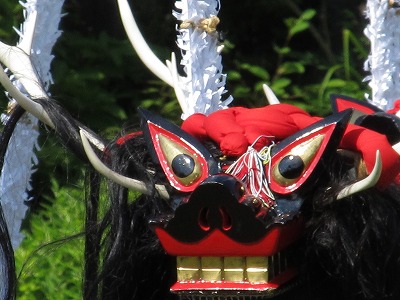

This self-drumming style is characterized by the long antlers on its head. They are made from real deer antlers. If it is broken, they will be provided by the hunter. Originally, the antlers had to be split into four pieces, but nowadays it is difficult to get the right ones. And the raised eyes. He carries a long pole (called “Sasala) on his back. There is a piece of paper wrapped around it. It is said that this is the gohei, in which dwells the deity. A drum is tied around his belly, and behind it, just like in the ogre sword dance, hangs an “ookuchi”. Basically, it consists of a group of eight people. It is said that the dance is handed down to the next generation in a group of eight people. The weight of the entire costume is about 15kg. In summer, the temperature is said to be around 40 degrees Celsius. However, one can only admire their light and harmonious movements that do not make you feel that at all. There are also several schools of the art, but they are mostly the same in appearance.

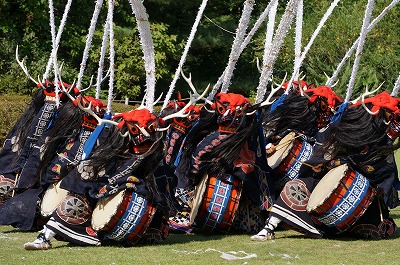
Like the ogre sword dance, each performance lasts about 10 minutes, and there are several different types, but I won’t go into details here. However, one of the features of the dance is that at the beginning of the performance, there is always a program called “Niwa-home” which means “praise the place you visit.” When they visit a shrine or a mansion, that performance is performed first, and then the rest of the performances follow. The Sasara is bent at the back and slammed onto the ground with force. It is believed that this is meant to drive away evil spirits of the land. Here, the host introduces the name and the program before it begins, but people who have never seen it before do not understand it well. A deep bass of the drumming seems to echo from the depths of the earth. And the occasional singing voice enters, adding to the effects–a visual that overwhelms the viewer. It was as if the cries of the souls of the Tohoku region could be heard.
Drape-style deer dance ~inland areas
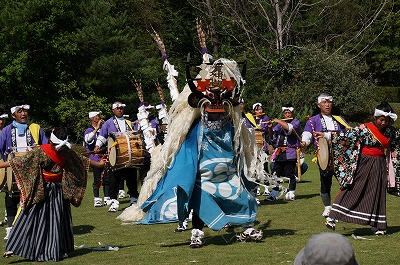
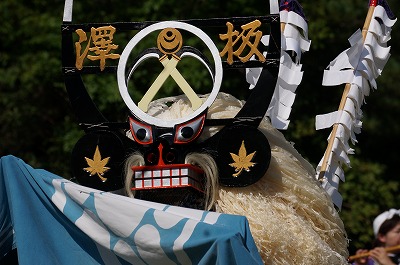
For a change, this time there will be a deer dance performed by a large group of people. This dance is called “drape-style” because the whole body is covered with a kind of drape. The appearance of the dance is also very different from the “self-drumming style”. First of all, they do not use real antlers. It involves an extremely inspirational design. The design also differs from region to region. The most representative one is the one in Tono City, which is located east of Kitakami City. The design is quite different except for the fact that it has raised eyes and a stick-like object on its back. Its most distinctive features are that it has a large amount of wood shavings called “kannagara” on its back, and the dance that causes the drape to rise and fall violently. Moreover, each group has its own role after the leader. There are more than 60 people in total (officially). However, it is difficult for all the groups to get that many people together, so the number can be increased or decreased as needed. Unlike the “self-drumming style ,” there are separate drums and flutes, and the shishis focus on dancing. Men play the role of the deer, and many women play the role of “Nakataiko” or “Katanakake”. However, in the olden days, all the roles were performed only by men and none were taught to women because women might eventually leave to other areas. This was because they were afraid that other communities would copy their methods.
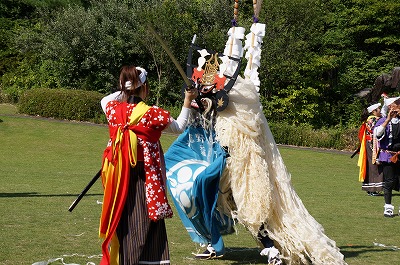
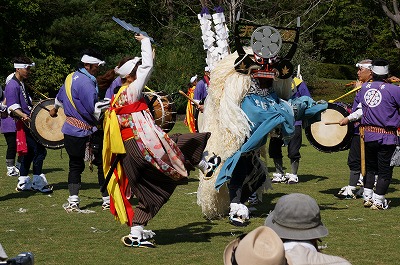
Drape-style deer dance ~coastal area
The dance is done in such a plaza with the whole thing going around in a circle. Basically, drums and flutes are often set aside. And the shishis raise the drape violently and shake their heads from side to side while squatting down. Those who are good at it have a keen sense of how to handle the drape. In the role called “Katanakake”, the actor dances holding his sword in the air while facing the shishi. It looks as if they are confronting the shishi.
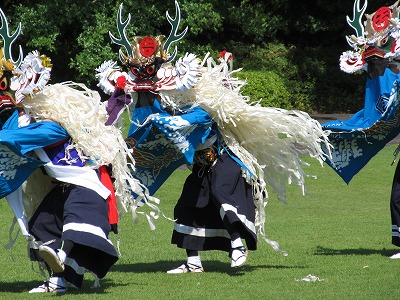
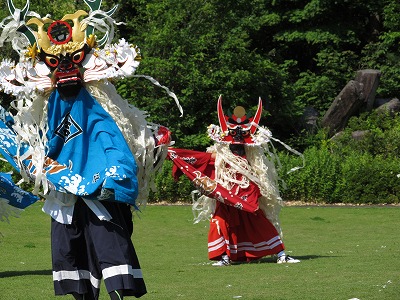
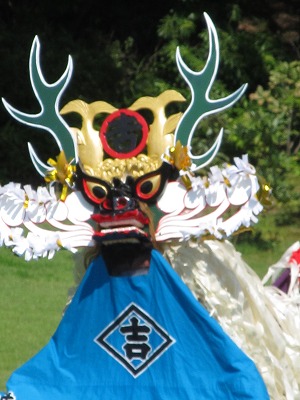
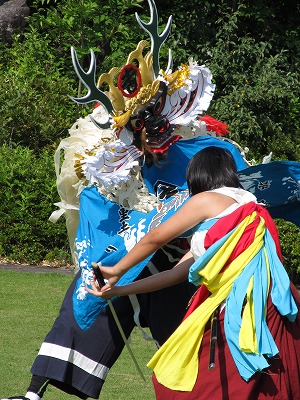
Drape-style Deer dance outside of Tono also makes an appearance. Unlike the taiko style, the drape style has many variations. For example, the shishi in Kamaishi City, on the coast, use really flamboyant colors. Their bodies are bright blue and their heads are more ornamental. There are also doe that are clearly recognizable by different colors, like the lion dance in Kanto. There is also a performance called “Tsunagakari,” in which the performers go over a single tight rope through trial and error, which is also in the Kanto style. If you ask the origin, you’ll find out that it was learned from fishermen who finally arrived after drifting from Chiba (Kanto) in the olden days.
Others
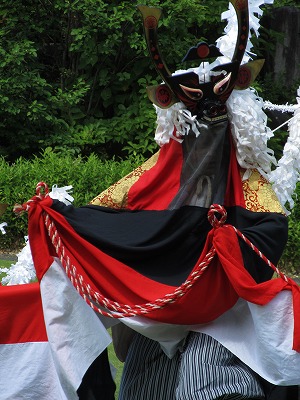

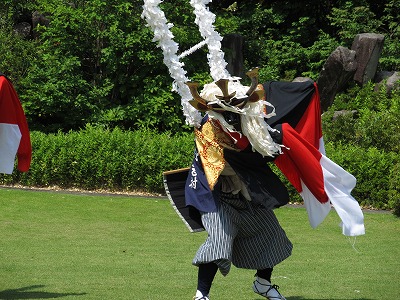
There are also other much performed deer dances. On the other hand, there are also more designed and impressive and slender deer dances like the ”Hakoishi” deer dance (Miyako city). A slender figure and a bright contrast of red and black costumes. It’s really unique.
Thus, the drape style can be enjoyed in a variety of designs. On the other hand, the self-druming style is not as interesting, but its dignity cannot be imitated. You can feel its awesomeness on the main street on Saturday night. If the finale of the festival is the ogre Sword Dance group dance, what should be called the “Deer Dance Group Dance” will take place shortly before that.
Corps de deer dance ~Night part
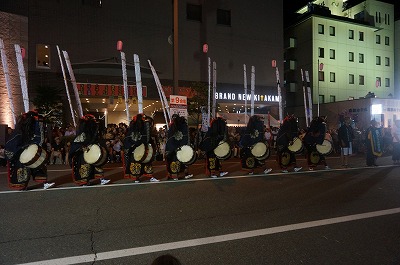
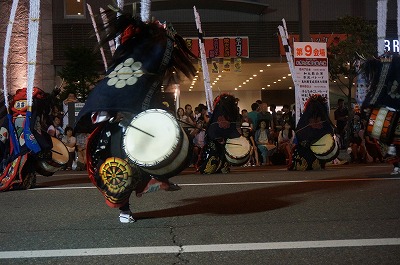
Although it is not like the demon sword dance where everyone dances the same program at the same time, it is very powerful to see as many as 10 deer dancing groups performing at the same time. Especially it is overwhelming to watch the drummers. Of course, the Maku-kei is nothing less impressive than those performances. The sound of the drums shaking the earth and the singing voice echoing in the depths of the stomach. The power to make the earth tremble. In reality, though, the earth doesn’t shake because it’s on concrete.
It is possible to move around to see several groups, but the 20 minutes go by very quickly. I recommend you to take your time and focus on just one or two, if possible.


A Miraculous Experience of the Deer Dance
Finally, I would like to share two interesting experiences I had. When I was about to leave the hotel to watch the night session, I found a self-drumming style deer dancing man standing in the backyard. Apparently, he had just finished getting dressed there and was about to go to the venue. I was so surprised that I was allowed to take a picture of him up close. When he asked ”where did you come from?”, I replied, “From Tokyo area”. He was delighted and said, “Good to see you from afar. I am grateful to you for visiting me from such a distance. Then I said, “Well, let’s have a dance,” and he beat the drum in front of me and danced lightly. It is impossible to describe the power of this performance in words. I remember that the surprised hotel staff came out of the hotel to see what was going on. And then the deer dancer walked away leisurely. I remember it as vividly as if it was yesterday.
And here is one more episode. I was watching the Deer Dance in the daytime, not wanting to miss a second of it. I had taken a camera and videotaped it. Halfway through, my batteries ran out. But the dance wasn’t over yet at all. I hurriedly took out my cellphone and filmed the remaining part. When I was relieved that I could record till the end, I remembered something. Probably from the impact of dropping it, I remembered that the smartphone’s camera function had been disabled for a while now. But I was able to take a picture safely. And ye after this one moment my camera hadn’t recovered until I changed it to a new one.
You have to actually visit the place to see it. Miracles don’t happen just by looking at images and photos. I highly recommend you to visit the place and experience it for yourself.